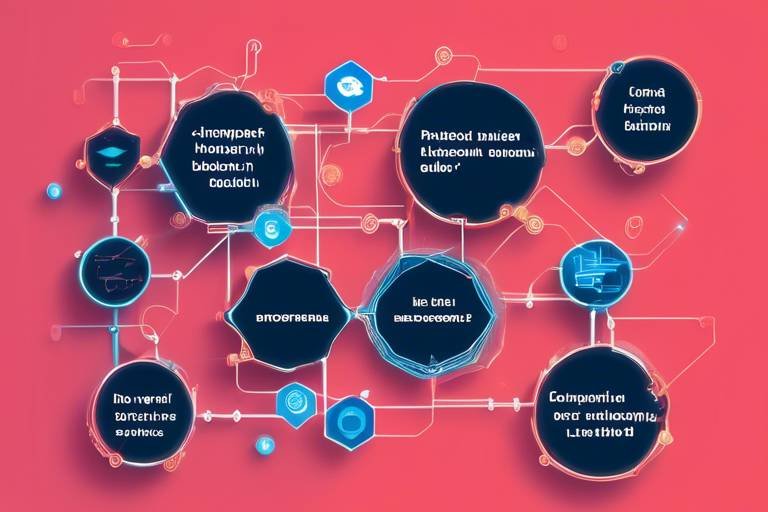The Impact of Blockchain on Financial Services - Opportunities and Challenges
Blockchain technology is not just a buzzword; it's a revolutionary force that's reshaping the landscape of financial services. Imagine a world where transactions are instantaneous, costs are slashed, and trust is built into the very fabric of every financial interaction. Sounds like a dream, right? Well, that's the potential of blockchain! As we dive into this exciting topic, we'll explore how blockchain is transforming the financial sector, the incredible opportunities it presents, and the hurdles that institutions must overcome to fully harness its power.
At its core, blockchain is a decentralized digital ledger that securely records transactions across a network of computers. Unlike traditional databases, where a single entity controls the data, blockchain distributes that control, making it inherently more secure and transparent. Each transaction is grouped into a block, and once a block is filled, it is added to a chain of previous blocks—hence the name "blockchain." This structure not only ensures data integrity but also allows for real-time updates, which is a game-changer for financial services.
One of the most exciting aspects of blockchain is its ability to enhance financial transactions. Here are some of the key benefits:
- Increased Speed: Traditional banking can take days for transactions to process, especially across borders. Blockchain can reduce this to mere minutes or even seconds!
- Reduced Costs: By eliminating intermediaries, blockchain can significantly lower transaction fees, making financial services more accessible to everyone.
- Improved Transparency: Every transaction is recorded on a public ledger, providing a level of transparency that builds trust among users.
These benefits can lead to a more efficient and user-friendly financial system, ultimately transforming how we think about money and transactions.
Imagine a contract that executes itself when certain conditions are met. That's the magic of smart contracts. These self-executing contracts have the terms of the agreement directly written into code, eliminating the need for intermediaries like lawyers or notaries. This automation can streamline processes such as loan approvals or insurance claims, reducing time and costs significantly. But while the potential is enormous, there are also challenges in ensuring the code is secure and the terms are clear.
With great power comes great responsibility, and the same goes for blockchain. As financial institutions look to adopt this technology, they face significant regulatory challenges. The landscape is complex, with different jurisdictions having varying laws and regulations. Financial institutions must navigate compliance issues, legal frameworks, and the need for regulatory clarity in this rapidly evolving space. Without clear guidelines, the risk of non-compliance can deter organizations from fully embracing blockchain.
While blockchain is often praised for its security features, it is not immune to vulnerabilities. Cybersecurity remains a critical concern, especially as financial services become more digitized. Potential risks include hacking attempts, phishing scams, and the possibility of human error in smart contracts. Organizations must implement robust security measures to mitigate these risks and protect sensitive data. This includes regular audits, employee training, and adopting best practices in cybersecurity.
The rise of blockchain technology presents both threats and opportunities for traditional banking institutions. Banks are now faced with the challenge of adapting to this new landscape while also leveraging the benefits that blockchain offers. Some banks are investing in blockchain technology to improve their services, while others are exploring partnerships with fintech companies to stay competitive. The impact on their business models could be profound, as they may need to rethink their strategies to accommodate a more decentralized financial ecosystem.
Decentralized Finance, or DeFi, is one of the most exciting applications of blockchain technology. By leveraging blockchain, DeFi aims to recreate traditional financial systems—like lending, borrowing, and trading—without the need for intermediaries. This opens up a world of possibilities for individuals who may not have access to traditional banking services. However, with these opportunities come challenges, including regulatory scrutiny and the need for consumer protection.
As blockchain technology continues to evolve, we can expect to see new trends emerge in its adoption across financial services. Innovations such as interoperability between different blockchain networks, advancements in privacy features, and the integration of artificial intelligence could redefine how we use blockchain. The future is bright, but it will require collaboration between regulators, financial institutions, and technology providers to ensure a smooth transition.
To truly understand the impact of blockchain in financial services, it's essential to look at real-world examples. Companies like Ripple and Chainalysis have successfully implemented blockchain solutions to enhance transaction speeds and improve transparency. These case studies provide valuable insights into the benefits and challenges organizations face when adopting this technology, paving the way for others to follow suit.
What is blockchain technology?
Blockchain is a decentralized digital ledger that records transactions securely across multiple computers, ensuring transparency and data integrity.
How does blockchain improve financial transactions?
Blockchain enhances financial transactions by increasing speed, reducing costs, and improving transparency, making the process more efficient.
What are smart contracts?
Smart contracts are self-executing contracts with the terms of the agreement directly written into code, allowing for automation in various financial processes.
What regulatory challenges does blockchain face?
Blockchain adoption faces regulatory challenges due to varying laws and compliance issues across different jurisdictions.
What is Decentralized Finance (DeFi)?
DeFi is a movement that uses blockchain technology to recreate traditional financial systems without intermediaries, offering more accessibility to financial services.

Understanding Blockchain Technology
Blockchain technology is often described as a decentralized digital ledger that records transactions across a network of computers in a secure and transparent manner. Imagine a digital notebook that everyone can see but no one can erase—this is essentially what blockchain offers. Each transaction is grouped into a block, and once a block is filled, it is added to a chain of previous blocks, hence the name "blockchain." This structure not only ensures that all transactions are recorded but also makes it incredibly difficult to alter any information without consensus from the network.
One of the key characteristics of blockchain is its decentralization. Unlike traditional financial systems that rely on a central authority, such as a bank, blockchain operates on a peer-to-peer network. This means that no single entity has control over the entire system, which significantly reduces the risk of fraud and increases trust among users. Additionally, every participant in the network has access to the same information, promoting transparency and accountability.
Another important aspect is the concept of immutability. Once a transaction is recorded on the blockchain, it cannot be changed or deleted, creating a permanent and verifiable record. This feature is particularly appealing for financial services, where trust and accuracy are paramount. The use of cryptographic techniques ensures that the data is secure, making it nearly impossible for unauthorized parties to tamper with it.
Moreover, blockchain operates on a consensus mechanism, which is the process by which all participants in the network agree on the validity of transactions. There are various consensus algorithms, such as Proof of Work and Proof of Stake, each with its own advantages and disadvantages. These mechanisms not only validate transactions but also help in maintaining the integrity of the blockchain.
In summary, blockchain technology is a groundbreaking innovation that has the potential to transform financial services. Its decentralized nature, transparency, immutability, and security features make it an attractive option for institutions looking to enhance their operations. However, understanding the underlying principles of blockchain is crucial for organizations aiming to leverage its capabilities effectively.

Opportunities in Financial Transactions
Blockchain technology is not just a buzzword; it’s a game-changer in the realm of financial transactions. Imagine a world where sending money across borders is as simple and instantaneous as sending an email. Well, that’s exactly what blockchain enables! By eliminating the need for intermediaries, blockchain can significantly reduce transaction times and costs, making financial transactions faster and more efficient than ever before.
One of the most exciting opportunities that blockchain presents is the potential for increased transparency. Every transaction recorded on a blockchain is visible to all participants in the network, which fosters trust and accountability. This transparency can help mitigate fraud and corruption, as all parties can verify transaction histories without the need for a central authority. Think of it as a public ledger that everyone can see but no one can tamper with. This characteristic is particularly beneficial in sectors like supply chain management, where tracking the provenance of goods is crucial.
Moreover, blockchain technology can facilitate microtransactions. Traditionally, small transactions have been economically unfeasible due to high fees associated with processing. However, with blockchain, the cost of processing these transactions can be dramatically lowered, opening up new avenues for business models that rely on micropayments. For instance, content creators can receive payments for individual pieces of work, allowing for a more direct relationship with their audience.
Another notable opportunity lies in the realm of cross-border payments. Currently, sending money internationally can take days and often incurs hefty fees. With blockchain, these transactions can be completed in a matter of minutes, with minimal fees, making it a more attractive option for both individuals and businesses. This is particularly important for migrant workers who send remittances back home, as it allows them to send more money to their families without being burdened by excessive fees.
In addition to these benefits, blockchain can enhance financial inclusion. Millions of people around the world lack access to traditional banking services. However, with blockchain-based solutions, individuals can engage in financial transactions without needing a bank account. All they need is a smartphone and internet access. This opens the door for underserved populations to participate in the global economy, empowering them to save, invest, and transact with ease.
To summarize, the opportunities presented by blockchain in financial transactions are nothing short of revolutionary. From increased speed and reduced costs to enhanced transparency and financial inclusion, the potential benefits are vast. As the technology continues to evolve, it will undoubtedly reshape the landscape of financial services, paving the way for a more efficient and equitable financial system.
- What is blockchain technology?
Blockchain is a decentralized digital ledger that securely records transactions across multiple computers, ensuring transparency and security.
- How does blockchain improve transaction speed?
By eliminating intermediaries and automating processes, blockchain can significantly reduce the time it takes to complete transactions.
- Can blockchain reduce transaction costs?
Yes, blockchain technology can lower transaction fees by streamlining processes and removing the need for third-party services.
- What are microtransactions?
Microtransactions are small financial transactions that are often impractical in traditional banking due to high fees, but blockchain makes them feasible.
- How does blockchain promote financial inclusion?
Blockchain allows individuals without bank accounts to participate in financial activities using just a smartphone and internet connection.

Smart Contracts and Automation
Imagine a world where contracts execute themselves without the need for a middleman. Smart contracts are the key to making this vision a reality. These are not your typical legal agreements; they are self-executing contracts with the terms of the agreement directly written into lines of code. This technology operates on the blockchain, ensuring that once the conditions are met, the contract automatically executes, eliminating the need for human intervention. Think of it as a vending machine: you insert a coin, make a selection, and the machine delivers your snack without any further action required. This level of automation is not only efficient but also incredibly reliable.
One of the most significant advantages of smart contracts is their ability to reduce costs. By removing intermediaries, such as lawyers and brokers, parties can save on fees and streamline transactions. For instance, in real estate, a smart contract can handle everything from the initial offer to the final transfer of ownership, all while ensuring that the conditions set forth in the contract are met before any money changes hands. This can significantly speed up transactions, which is a game-changer in industries that often suffer from delays.
Moreover, transparency is another crucial benefit. Since smart contracts are stored on a public blockchain, all parties involved can view the terms and track the execution process in real-time. This transparency builds trust among participants, as they can independently verify that the contract is being honored without relying on a third party. In sectors like supply chain management, this could mean tracking products from origin to consumer, ensuring that every step of the journey is recorded and verifiable.
However, while the potential of smart contracts is immense, there are challenges to consider. Security is paramount; if the code contains vulnerabilities, malicious actors could exploit these weaknesses. Additionally, the legal status of smart contracts varies by jurisdiction, which raises questions about enforceability. Are these digital agreements recognized in a court of law? As the technology evolves, so too must our understanding of the legal implications surrounding it.
To better understand how smart contracts can transform industries, consider the following table that outlines potential applications:
| Industry | Application | Benefits |
|---|---|---|
| Real Estate | Automated property transfers | Faster transactions, reduced costs |
| Insurance | Claims processing | Immediate payouts, fraud reduction |
| Supply Chain | Product tracking | Increased transparency, accountability |
| Finance | Loan agreements | Lower interest rates, faster approvals |
In conclusion, smart contracts represent a revolutionary leap forward in how we manage agreements. They offer a tantalizing glimpse into a future where automation and blockchain technology converge to create more efficient, transparent, and secure processes across various industries. As we continue to explore the potential of smart contracts, it’s essential to address the associated challenges to fully harness their power.
- What is a smart contract? A smart contract is a self-executing contract with the terms directly written into code on a blockchain.
- How do smart contracts work? They automatically execute when predetermined conditions are met, eliminating the need for intermediaries.
- What are the benefits of using smart contracts? Benefits include reduced costs, increased speed, and enhanced transparency in transactions.
- Are smart contracts legally binding? The legal status of smart contracts varies by jurisdiction, and their enforceability can depend on local laws.
- What industries can benefit from smart contracts? Industries such as real estate, insurance, supply chain management, and finance can all leverage smart contracts for improved efficiency.

Regulatory Challenges
As exciting as blockchain technology is, it doesn't come without its fair share of hurdles, particularly when it comes to . The rapid evolution of blockchain has outpaced the ability of regulatory bodies to keep up, leading to a complex landscape where compliance is often murky. Imagine trying to navigate a maze where the walls keep shifting; that’s what many financial institutions face today.
One of the primary issues is the lack of a cohesive legal framework. Different countries have different regulations regarding blockchain and cryptocurrencies, which can create confusion and uncertainty for businesses looking to adopt this technology. For instance, while some nations embrace blockchain with open arms, others impose strict regulations or outright bans. This inconsistency can stifle innovation and make it hard for companies to operate internationally.
Moreover, the decentralized nature of blockchain poses unique challenges for regulators. Traditional financial systems have clear points of accountability, but blockchain operates on a peer-to-peer network. This raises questions about who is responsible for compliance, especially when disputes arise. Who do you turn to when a smart contract fails? This ambiguity can lead to significant legal risks for organizations.
Another regulatory challenge is the issue of anti-money laundering (AML) and know your customer (KYC) compliance. Financial institutions are required to verify the identities of their customers to prevent illicit activities. However, the anonymity that blockchain can provide complicates these efforts. While some blockchain projects are working on solutions to enhance transparency, the balance between privacy and compliance remains a contentious topic.
To put it simply, the regulatory landscape for blockchain is like a game of chess. Institutions must anticipate moves from regulators while also strategizing their own initiatives. Here’s a quick overview of some key regulatory challenges:
| Challenge | Description |
|---|---|
| Lack of Cohesive Legal Framework | Inconsistent regulations across different countries create confusion. |
| Decentralization Issues | Ambiguity in accountability and compliance responsibilities. |
| AML and KYC Compliance | Difficulty in verifying identities due to blockchain's anonymity features. |
In conclusion, while blockchain holds immense promise for transforming financial services, navigating the regulatory landscape is akin to walking a tightrope. Financial institutions must be proactive in understanding these challenges and working closely with regulators to create a framework that fosters innovation while ensuring compliance. Only then can they fully harness the potential of blockchain technology without falling into the pitfalls of regulatory non-compliance.
- What are the main regulatory challenges facing blockchain? The main challenges include inconsistent legal frameworks, decentralization issues, and compliance with AML and KYC regulations.
- How do different countries regulate blockchain? Countries vary widely in their approach, with some embracing blockchain and others imposing strict regulations or bans.
- Why is decentralization a challenge for regulators? Decentralization makes it difficult to pinpoint accountability and compliance responsibilities, complicating regulatory oversight.

Cybersecurity Concerns
In the ever-evolving landscape of financial services, cybersecurity remains a paramount concern, especially with the integration of blockchain technology. While blockchain is often lauded for its inherent security features, such as decentralization and cryptographic encryption, it is not immune to vulnerabilities. The very nature of blockchain, which allows for public access to transaction data, can also be a double-edged sword. Attackers may exploit weaknesses in the underlying code or the systems that interact with blockchain networks, leading to potential breaches.
One of the most significant risks associated with blockchain technology is the possibility of 51% attacks. In this scenario, a single entity gains control of more than half of the network's hashing power, allowing them to manipulate transactions. This could result in double-spending, where the same cryptocurrency is spent more than once, undermining the trust that is central to financial transactions.
Moreover, the rise of decentralized finance (DeFi) platforms, which operate without traditional intermediaries, introduces additional cybersecurity challenges. These platforms often lack the robust security measures that established financial institutions have in place. As a result, they can become prime targets for hackers. The infamous Poly Network hack in 2021, where over $600 million was stolen, serves as a stark reminder of the vulnerabilities present in the DeFi space.
To mitigate these risks, financial institutions and blockchain developers must prioritize security measures. Here are some essential strategies:
- Regular Audits: Conducting frequent security audits can help identify vulnerabilities before they are exploited.
- Multi-Signature Wallets: Utilizing wallets that require multiple signatures for transactions can add an extra layer of security.
- Education and Training: Ensuring that all stakeholders understand cybersecurity best practices is crucial for minimizing human error.
Additionally, regulatory bodies are beginning to recognize the importance of cybersecurity in the blockchain space. As governments develop frameworks for blockchain technology, they are also focusing on establishing guidelines for cybersecurity protocols. This regulatory clarity is vital for fostering trust and encouraging broader adoption of blockchain in financial services.
In conclusion, while blockchain technology offers exciting opportunities for innovation in financial services, it is essential to remain vigilant about cybersecurity concerns. By implementing robust security measures and adhering to regulatory guidelines, institutions can harness the power of blockchain while safeguarding against potential threats.
Q: What are the main cybersecurity risks associated with blockchain?
A: The primary risks include 51% attacks, vulnerabilities in smart contracts, and hacking of decentralized finance platforms.
Q: How can organizations enhance their blockchain security?
A: Organizations can enhance security through regular audits, using multi-signature wallets, and educating their teams on cybersecurity best practices.
Q: Is blockchain completely secure?
A: While blockchain has strong security features, it is not completely secure. Risks still exist, particularly from external attacks and vulnerabilities in associated systems.

Impact on Traditional Banking
The rise of blockchain technology is nothing short of a seismic shift in the world of finance, and traditional banking is feeling the tremors. As banks grapple with the implications of this innovative technology, they find themselves at a crossroads. Will they embrace blockchain and adapt, or will they cling to old models and risk obsolescence? This dilemma is akin to watching a seasoned ship captain navigate through uncharted waters—there's both excitement and trepidation.
At its core, blockchain offers an unprecedented level of transparency and efficiency that can fundamentally alter the way banks operate. Traditional banking systems are often bogged down by layers of bureaucracy and lengthy processes. However, with blockchain, transactions can be executed in real-time, significantly reducing waiting times. Imagine a world where you can transfer funds across borders in a matter of minutes instead of days—that’s the promise of blockchain technology!
Moreover, the cost structures of traditional banking could be disrupted. Banks typically incur substantial operational costs due to intermediaries, compliance checks, and transaction fees. Blockchain's decentralized nature allows for peer-to-peer transactions, which can lead to lower costs for consumers and businesses alike. As banks begin to adopt blockchain solutions, they may find themselves rethinking their entire business models, potentially leading to a more customer-centric approach.
However, this transformation is not without its challenges. Traditional banks are not just facing competition from fintech startups leveraging blockchain; they are also contending with the need to integrate this technology into their existing frameworks. This integration can be daunting, requiring substantial investments in technology and training. Additionally, banks must navigate a complex landscape of regulations that vary significantly across jurisdictions. For instance, while some countries are embracing blockchain with open arms, others remain skeptical or even hostile.
To illustrate the potential impact of blockchain on traditional banking, consider the following table that outlines some key opportunities and challenges:
| Opportunities | Challenges |
|---|---|
| Enhanced transaction speed | Regulatory compliance complexities |
| Reduced operational costs | Integration with existing systems |
| Improved customer experience | Cybersecurity risks |
| New revenue streams | Resistance to change from within |
In conclusion, the impact of blockchain on traditional banking is profound and multifaceted. While it presents exciting opportunities for innovation and growth, it also poses significant challenges that banks must address head-on. The question remains: will traditional banks rise to the occasion and innovate, or will they become relics of a bygone era? Only time will tell, but one thing is certain: the future of banking is being rewritten, and blockchain is at the forefront of this revolution.
Q: What is blockchain technology?
A: Blockchain is a decentralized digital ledger that records transactions across multiple computers, ensuring transparency and security.
Q: How does blockchain impact traditional banking?
A: Blockchain enhances transaction speed, reduces costs, and improves customer experience, but it also presents challenges like regulatory compliance and cybersecurity risks.
Q: Are banks adopting blockchain technology?
A: Yes, many banks are exploring blockchain solutions to improve their operations and stay competitive in an evolving financial landscape.
Q: What are smart contracts?
A: Smart contracts are self-executing contracts with the terms directly written into code, allowing for automated processes and reducing the need for intermediaries.

Decentralized Finance (DeFi)
Decentralized Finance, commonly referred to as DeFi, is one of the most exciting innovations made possible by blockchain technology. Imagine a world where financial services are accessible to anyone with an internet connection, eliminating the need for traditional banks and intermediaries. Sounds like a dream, right? Well, DeFi is turning that dream into reality! By leveraging smart contracts and blockchain, DeFi platforms are creating a financial ecosystem that is open, transparent, and inclusive.
At its core, DeFi aims to recreate traditional financial systems—like lending, borrowing, and trading—without the need for central authorities. This means that users can interact directly with each other, using decentralized applications (dApps) that operate on blockchain networks. The implications are profound, as they democratize access to financial services, allowing anyone, regardless of their location or financial background, to participate in the economy.
One of the standout features of DeFi is its ability to offer yield farming and liquidity mining. These processes allow users to earn rewards by providing liquidity to various protocols. For instance, when you lend your cryptocurrency to a DeFi platform, you can earn interest rates that are often significantly higher than those offered by traditional banks. This creates an attractive opportunity for individuals looking to maximize their returns on investments.
However, while the potential of DeFi is immense, it’s crucial to understand the risks involved. The decentralized nature of these platforms means that they often operate without regulatory oversight, which can lead to vulnerabilities. Issues such as smart contract bugs, hacking incidents, and lack of consumer protection are prevalent in the DeFi space. Therefore, it’s essential for users to conduct thorough research and exercise caution when engaging with DeFi platforms.
To further illustrate the growth and impact of DeFi, let’s take a look at some key statistics:
| Metric | Value |
|---|---|
| Total Value Locked (TVL) | $100 billion (as of 2023) |
| Number of DeFi Protocols | Over 400 |
| Average Annual Percentage Yield (APY) | 10% - 30% |
As you can see, the DeFi landscape is not just a passing trend; it’s a rapidly growing sector that is reshaping the financial world. With the increasing adoption of blockchain technology, we can expect to see even more innovative solutions emerging in the DeFi space, allowing for greater financial inclusion and efficiency.
In conclusion, DeFi represents a revolutionary shift in how we think about and interact with financial services. It challenges the status quo and offers individuals unprecedented control over their financial assets. However, with great power comes great responsibility. As users navigate this new terrain, they must remain vigilant and informed to fully harness the benefits while mitigating the risks associated with decentralized finance.
- What is DeFi? DeFi stands for Decentralized Finance, a movement that aims to recreate traditional financial systems using blockchain technology.
- How does DeFi work? DeFi operates on blockchain networks using smart contracts, allowing users to interact directly without intermediaries.
- What are the risks of using DeFi? Risks include smart contract vulnerabilities, lack of regulation, and potential hacking incidents.
- Can anyone participate in DeFi? Yes! Anyone with an internet connection can access DeFi platforms and services.

Future Trends in Blockchain Adoption
As we gaze into the crystal ball of financial services, it's clear that blockchain technology is not just a fleeting trend but a transformative force that is reshaping the landscape. The future of blockchain adoption is poised to unveil numerous exciting developments that could redefine how we conduct financial transactions, interact with institutions, and manage assets. One of the most significant trends is the increasing integration of blockchain with artificial intelligence (AI). By marrying these two technologies, we can expect enhanced decision-making processes, improved fraud detection, and more personalized financial services.
Moreover, the rise of central bank digital currencies (CBDCs) is another trend gaining momentum. Governments worldwide are exploring the potential of CBDCs to provide a stable digital currency option that could coexist with traditional fiat currencies. This shift could lead to a more efficient payment system and greater financial inclusion for unbanked populations. Imagine a world where anyone with a smartphone can access banking services without the need for a physical bank branch!
In addition, the concept of interoperability between different blockchain networks is becoming increasingly important. As various industries adopt blockchain, the need for these networks to communicate with one another will grow. This could lead to the development of standardized protocols, allowing for seamless transactions across different platforms. Picture a scenario where you can transfer assets from one blockchain to another without the hassle of multiple conversions or intermediaries. This future is not far off!
Another exciting trend is the expansion of DeFi (Decentralized Finance). As more users become familiar with blockchain technology, the demand for decentralized financial services will continue to rise. DeFi platforms are already disrupting traditional financial systems by offering services such as lending, borrowing, and trading without intermediaries. The future may see even more innovative DeFi solutions that cater to niche markets and underserved communities.
Furthermore, as regulatory frameworks evolve, we can expect a more structured approach to blockchain adoption. Governments and regulatory bodies are beginning to recognize the potential of blockchain and are working towards creating guidelines that foster innovation while ensuring consumer protection. This balance is crucial for building trust and encouraging widespread adoption.
Finally, the focus on sustainability within the blockchain space is gaining traction. As concerns about energy consumption and environmental impact grow, blockchain projects are increasingly looking for ways to become more eco-friendly. This includes adopting proof-of-stake mechanisms instead of traditional proof-of-work models, which are known for their high energy usage. The future of blockchain could very well be a green one!
In summary, the future trends in blockchain adoption are not only promising but also indicative of a broader shift towards a more efficient, inclusive, and secure financial ecosystem. As we continue to embrace these technologies, it's essential to stay informed and adaptable, ready to seize the opportunities that lie ahead.
- What is blockchain? Blockchain is a decentralized digital ledger that records transactions across multiple computers, ensuring transparency and security.
- How will blockchain impact financial services? Blockchain can enhance transaction speed, reduce costs, and improve transparency, transforming traditional financial practices.
- What are smart contracts? Smart contracts are self-executing contracts with the terms of the agreement directly written into code, automating processes in financial services.
- What are the regulatory challenges of blockchain? The adoption of blockchain faces complexities related to compliance, legal frameworks, and the need for regulatory clarity.
- What is DeFi? Decentralized Finance (DeFi) leverages blockchain to recreate traditional financial systems without intermediaries, offering innovative financial services.

Case Studies of Successful Implementation
As we delve into the world of blockchain technology, it’s essential to highlight real-world examples that illustrate its transformative potential in financial services. These case studies serve not only as proof of concept but also as a beacon of inspiration for other institutions considering the leap into the blockchain realm. Let's explore some notable implementations that showcase the benefits and challenges faced by organizations.
One of the most prominent examples is the partnership between IBM and Maersk, which launched the TradeLens platform. This blockchain-based supply chain solution aims to enhance transparency and efficiency in global trade. By providing a shared, immutable ledger, TradeLens allows all parties involved in the shipping process—from suppliers to logistics companies—to access real-time data. This initiative has significantly reduced the time it takes to track shipments and has minimized disputes over documentation. The result? A more streamlined supply chain that saves time and costs.
Another fascinating case is the implementation of blockchain technology by American Express. They have integrated blockchain into their payment processing system, particularly for cross-border transactions. By utilizing blockchain, American Express has been able to offer faster transaction speeds and lower fees compared to traditional methods. Customers benefit from enhanced transparency, as they can track their payments in real-time, leading to increased trust in the system. This case exemplifies how established financial institutions can innovate by adopting cutting-edge technologies.
In the realm of decentralized finance, Uniswap has emerged as a revolutionary platform that allows users to trade cryptocurrencies without intermediaries. This decentralized exchange utilizes smart contracts on the Ethereum blockchain to facilitate trades directly between users. The success of Uniswap has demonstrated the potential of DeFi to disrupt traditional financial models, providing users with greater control over their assets and reducing reliance on banks. Uniswap's rise has sparked interest in numerous other DeFi projects, showcasing the demand for decentralized solutions in the financial market.
However, while these implementations highlight the potential of blockchain, they also bring forth challenges. For instance, the integration of blockchain into existing systems can be complex and costly. Organizations must navigate the intricacies of technology adoption, including training staff and ensuring compatibility with current infrastructure. Moreover, the regulatory landscape remains a significant hurdle, as many jurisdictions are still formulating policies that govern blockchain use.
To summarize, the case studies of IBM and Maersk, American Express, and Uniswap illustrate the profound impact blockchain can have on financial services. These examples highlight not only the opportunities for increased efficiency and transparency but also the challenges that come with implementing such a transformative technology. As more organizations explore blockchain, we can expect to see a growing number of successful implementations that pave the way for a more innovative financial landscape.
- What is blockchain technology?
Blockchain is a decentralized digital ledger that records transactions across multiple computers, ensuring transparency and security.
- How does blockchain benefit financial services?
Blockchain enhances financial services by increasing transaction speed, reducing costs, and improving transparency.
- What are smart contracts?
Smart contracts are self-executing contracts with the terms directly written into code, allowing for automation in financial transactions.
- What challenges does blockchain face in financial services?
Challenges include regulatory hurdles, integration complexities, and cybersecurity concerns.
Frequently Asked Questions
- What is blockchain technology?
Blockchain technology is a decentralized digital ledger that records transactions across multiple computers. It ensures that the data is secure, transparent, and immutable, making it ideal for various applications, especially in financial services.
- How does blockchain enhance financial transactions?
Blockchain enhances financial transactions by increasing speed, reducing costs, and improving transparency. It eliminates the need for intermediaries, which can slow down transactions and add fees, allowing for quicker and more efficient exchanges.
- What are smart contracts, and how do they work?
Smart contracts are self-executing contracts where the terms of the agreement are written into code. They automatically execute actions when predetermined conditions are met, streamlining processes and reducing the need for intermediaries in financial transactions.
- What regulatory challenges does blockchain face?
The adoption of blockchain in financial services faces significant regulatory challenges, including compliance complexities and the need for clear legal frameworks. Financial institutions must navigate these regulations to ensure they operate within the law while leveraging blockchain technology.
- Are there cybersecurity concerns with blockchain?
While blockchain is often praised for its security features, it is not immune to vulnerabilities. Cybersecurity concerns include potential hacking attempts and data breaches. Organizations must implement robust security measures to mitigate these risks effectively.
- How is blockchain impacting traditional banking?
Blockchain presents both threats and opportunities for traditional banking institutions. Banks are adapting by exploring blockchain solutions to enhance efficiency and reduce costs, while also facing competition from decentralized finance (DeFi) platforms that challenge their business models.
- What is Decentralized Finance (DeFi)?
Decentralized Finance (DeFi) refers to a financial system built on blockchain technology that operates without intermediaries. It aims to recreate traditional financial services, such as lending and trading, in a more open and accessible manner, often leading to lower costs and increased efficiency.
- What future trends can we expect in blockchain adoption?
Future trends in blockchain adoption may include increased integration with artificial intelligence, enhanced regulatory frameworks, and broader acceptance of cryptocurrencies. As the technology evolves, we can expect to see innovative applications that further transform financial services.
- Can you provide examples of successful blockchain implementation?
Yes! There are several notable case studies showcasing successful blockchain implementation in financial services. These include initiatives by companies like Ripple, which focuses on cross-border payments, and IBM's Food Trust, which enhances supply chain transparency through blockchain.



















